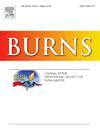Understanding burn injury among Aboriginal and Torres Strait Islander children – results of a two-year cohort study
IF 3.2
3区 医学
Q2 CRITICAL CARE MEDICINE
引用次数: 0
Abstract
Background
Despite known inequalities, little is understood about the burden and healthcare experiences of Aboriginal and Torres Strait Islander children who sustain a burn injury and their families.
Methods
The Coolamon Study recruited parents and carers whose children (aged <16 years) were Aboriginal and / or Torres Strait Islander children and had presented to burn units across four Australian states, New South Wales (Sydney), Northern Territory (Darwin), Queensland (Brisbane, Townsville) and South Australia (Adelaide), between 2015 and 2018. Consent was obtained and carers completed baseline and subsequent interviews at 3, 6, 12 and 24 months. Data were collected on the injury event, patient care and safety, sociodemographic factors, health related quality of life (PedsQual), and psychological distress (Kessler K-5).
Results
Of the 208 participants, 64 % were male; 26 % were aged less than 2 years and 37 % aged 2–4 years. The most common burn mechanisms were scalds (37 %), contact (33 %) and flame burns (21 %), with more severe burns and flame burns occurring in rural and remote settings. Most carers rated their child’s care as either excellent or very good (82 %). Family distress, measured by the K-5, lessened over the 24 months, however the changes were not statistically significant. While 77 % of carers reported that they received enough information, 18 % reported they would have liked more, and 3 % reported no information was provided before treatment. Parents described mixed access to information about the types of support available to them, such as accommodation, meals, travel or cultural support.
Conclusion
Data from this cohort provide rich new information about risk factors and care received from point of injury through to rehabilitation for Aboriginal and Torres Strait Islander children with burns, providing unique insights into what is needed for appropriate, culturally safe care.
了解土著居民和托雷斯海峡岛民儿童的烧伤情况--为期两年的队列研究结果。
背景:尽管存在已知的不平等现象,但人们对烧伤的土著居民和托雷斯海峡岛民儿童及其家庭的负担和医疗保健经历知之甚少:Coolamon 研究招募了其子女(年龄为 5 岁)的父母和照顾者:在 208 名参与者中,64% 为男性;26% 年龄小于 2 岁,37% 年龄为 2-4 岁。最常见的烧伤机制是烫伤(37%)、接触性烧伤(33%)和火焰烧伤(21%),农村和偏远地区的烧伤和火焰烧伤更为严重。大多数照护者将孩子的照护工作评为 "优秀 "或 "非常好"(82%)。在 24 个月的时间里,以 K-5 为指标的家庭痛苦程度有所减轻,但变化在统计学上并不显著。77%的照护者表示他们获得了足够的信息,18%的照护者表示他们希望获得更多信息,3%的照护者表示在治疗前没有获得任何信息。家长们对可获得的支持类型信息(如住宿、膳食、旅行或文化支持)的描述不一:来自该队列的数据提供了有关土著居民和托雷斯海峡岛民烧伤儿童从受伤到康复期间的风险因素和护理的丰富新信息,为了解适当的、文化上安全的护理所需的条件提供了独特的见解。
本文章由计算机程序翻译,如有差异,请以英文原文为准。
求助全文
约1分钟内获得全文
求助全文
来源期刊

Burns
医学-皮肤病学
CiteScore
4.50
自引率
18.50%
发文量
304
审稿时长
72 days
期刊介绍:
Burns aims to foster the exchange of information among all engaged in preventing and treating the effects of burns. The journal focuses on clinical, scientific and social aspects of these injuries and covers the prevention of the injury, the epidemiology of such injuries and all aspects of treatment including development of new techniques and technologies and verification of existing ones. Regular features include clinical and scientific papers, state of the art reviews and descriptions of burn-care in practice.
Topics covered by Burns include: the effects of smoke on man and animals, their tissues and cells; the responses to and treatment of patients and animals with chemical injuries to the skin; the biological and clinical effects of cold injuries; surgical techniques which are, or may be relevant to the treatment of burned patients during the acute or reconstructive phase following injury; well controlled laboratory studies of the effectiveness of anti-microbial agents on infection and new materials on scarring and healing; inflammatory responses to injury, effectiveness of related agents and other compounds used to modify the physiological and cellular responses to the injury; experimental studies of burns and the outcome of burn wound healing; regenerative medicine concerning the skin.
 求助内容:
求助内容: 应助结果提醒方式:
应助结果提醒方式:


